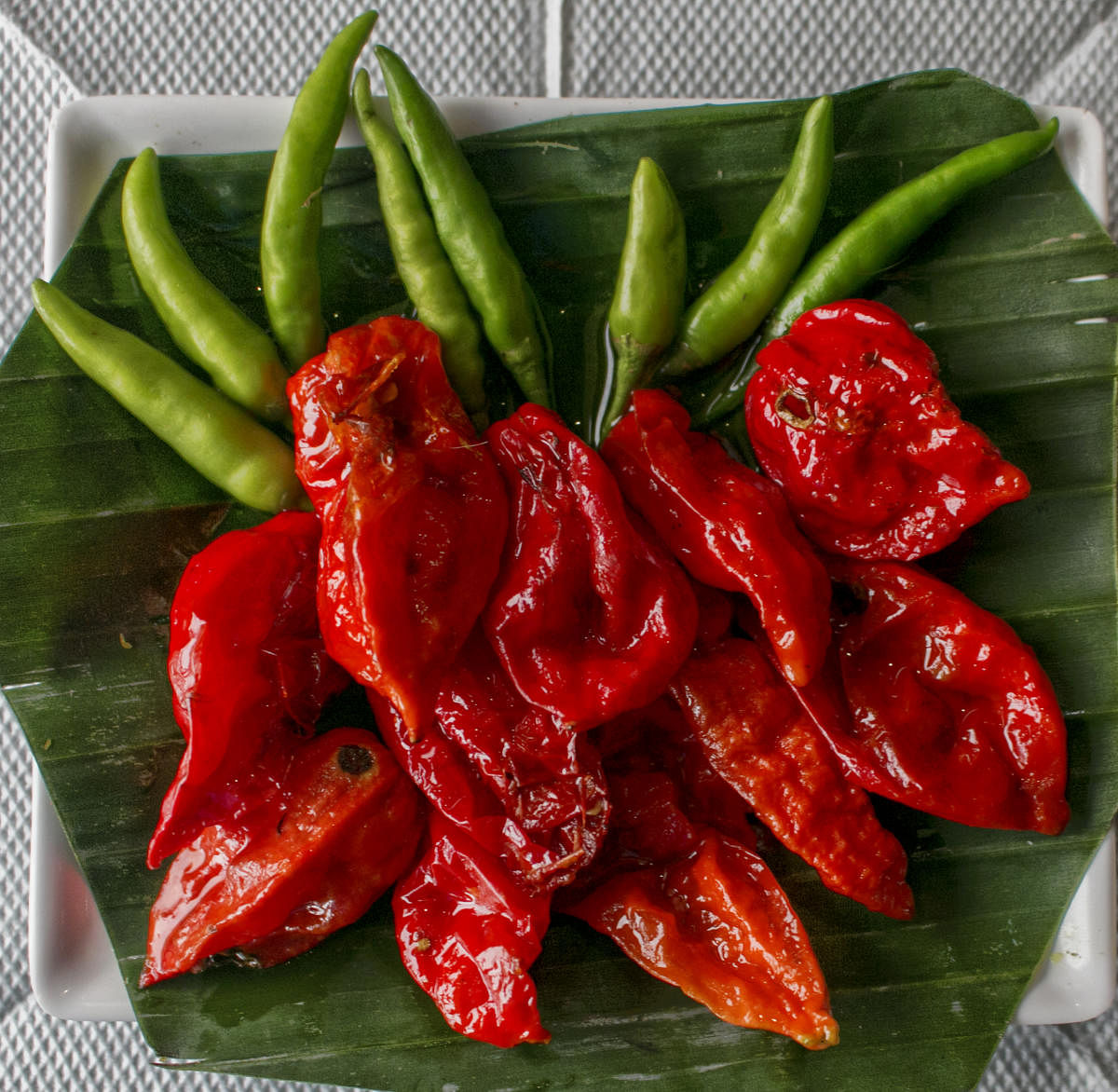
In the warm and cosy kitchen of the homestay in Lachen in North Sikkim, we huddled together as the rains lashed the countryside. The matriarch served a delicious meal of hot soup, beans and potato stew, steamed rice and masoor dal (split red lentil). Then she placed a bowl of round, red chilli pickles that glistened like cherries in oil.
The fiery punch of the delectable dalles, Sikkim’s signature chilli, was what one craved for on a rainy day. Known as dalle khursani chilli, it could spice up even a bland dish. Eaten raw with meals, ground as a chutney to dip momos, dried or powdered. But pickling in oil is the best way to enjoy it year-round. The flavoursome fruitiness makes it palatable, despite the high 100000-350000 SHU. The Scoville Heat Units (SHU) is the unit of measurement of the pungency or heat of the chilli, based on the concentration of capsaicin (a chemical compound), on a Scoville scale.
India has numerous varieties of chillies. Introduced in the 16th century by the Portuguese from South America, India today reigns supreme in the production, export and consumption of chillies. It also spawned superstitions to ward off the evil eye or summon good fortune by hanging nimboo mirchi. Chillies surely turn up the heat across the country.
The Andhra cuisine ferocity could be attributed to the highly piquant Guntur Sannam chilli. Due to its popularity, it corners 30 percent of India’s chilli export. Guntur Sannam, Naga mircha (Nagaland), Mizo chilli (Mizoram), Byadgi chilli (Karnataka), Bhiwapur chilli (Maharashtra) and Khola chilli (Goa), Dalle Khursani (Sikkim) and Edayur chilli (Kochi) are marked with GI (Geographical Indication) tag.
In Vidarbha (part of Maharashtra) Ellachipur Sannam-S4 chilli could be responsible for the fiery thecha (eaten with jhunka bhakri), chicken waradi and Nagpur’s Saoji chicken curry.
Some of the hottest chilli-centric non-vegetarian curries could induce tears and tingle the taste buds. Foodies love Rajasthan’s laal maas and jungli maas, Kashmir’s Rista and rogan josh, Nagamese pork curry, Goa’s Vindaaloo, Andhra Chilli Chicken, Kolhapuri chicken and Kozhi curry.
But nothing compares to the sizzling sensation of the world’s hottest phaal curry made of chicken and Bhut Jolokia, the ghost chilli of Assam and Nagaland. Hailed as the World’s hottest chilli in 2007 in the Guinness World Records, it made Northeast hot at 1041427 SHU.
Bhut Jolokia has found its way in pepper sprays, tear gases and hand grenades as non-lethal weapons. Taking a leaf out of the classic movie, Mirch Masala where women thrust chilli powder into their tormentor’s eyes, a pepper spray in a woman’s purse keeps her confident for self-defence.
You could find these fiery red chillies sold in bamboo baskets at local vegetable markets or at the wholesale market of Machkhowa in Guwahati. Visiting a chilli market could be daunting with a thick pungent smell pervading the place. Experience of Khari Baoli street in Delhi and the chilli market at Guntur in Andhra Pradesh is enough. There’s even an annual chilli festival, Hathei Phanit festival, held in the Sirarakhong village in Ukhrul district of Manipur where much sought after Hathei chilli grows.
India has unique varieties of chillies varying in colour, length, width, the thickness of skin and pungency. Though green and shades of red are common, Kanthari chillies of Kerala and Tamil Nadu are ivory white. The Kashmir and Deggi chilli powder are mild but lend an attractive bright red colour to any dish. The Byadgi chilli has a crinkly appearance. The round red Salem Gundu of Tamil Nadu is used for tempering sambhar and coconut chutney. Bhavnagri mirchi, Warangal Chappata, Nimari mirchi, Bangalore Torpedo chilli are few chillies associated with a place.
Chillies have a pride of place in Bhutan’s national dish Ema Datshi (chillies and cheese dish) and Thai Som tam (green papaya salad with a fistful of chopped Thai chilli). A stroll down the street of Paro, one would find heaps of red chillies drying on the parapets, painting the town scarlet. The dried red chillies are braided and hung over earthen stoves for use in harsh winters in village homes. Not only food but chilli-infused cocktails like Jalapeno Margarita and Habanero Pisco Sour could be a sizzling affair. The tangy chilli guava drink, chocolate-chilli ice cream and chilli chocolate bars would sting with sweetness. The chillies and chocolate combination had been popular since the ancient civilisations of the Mayans and Aztecs in South America.
Throughout Asia, chillies are used in umpteen ways. Fragrant Chinese hot chilli-oil, Schezwan chilli sauce, Indonesia’s spicy condiment Sambal Sambal, Thailand’s variety of chilli paste with shrimp or fish, Tibetan chilli dip to our own green chutney with chillies and coriander/raw mango could add a zing to any dish. Used in dips, sauces, curries, stew, pickles, spices, as seasoning; chillies add pungency, flavour, aroma and colour to them. Chillies are stars in lip-smacking chilli chicken, Hyderabadi mirchi ka salan, Rajasthani stuffed mirchi vada, Gujarati mirchi bhajia and Banarasi bharwan lal mirch ka achar.